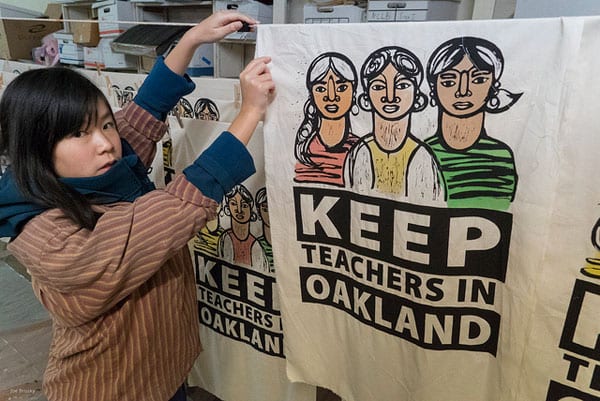
February 21, 2019; The Nation and San Francisco Chronicle
Oakland teachers went on strike yesterday “to demand lower class sizes, more support for students, better pay, and the preservation of public education, writes Eric Blanc in the Nation. Two weeks ago, NPQ noted that like a number of the #RedforEd wave of strikes, three issues are at the top of the strikers’ demands: “a living wage for all educators,” “class size reductions,” and “additional student supports.”
Now, Oakland’s 3,000 teachers have walked out. The district educates an estimated 37,000 students, with another 13,000 students citywide attending charter schools, according to Ashley McBride, Kimberly Veklerov, and Nanette Asimov in the San Francisco Chronicle.
Blanc highlights some of the connections with the broader teachers’ movement:
Like January’s walkout in Los Angeles, this is fundamentally a struggle to save Oakland’s schools from the downsizing plans of billionaire privatizers. Oakland already has a higher percent of charter students than any other city in California—and this number is set to skyrocket if the school board is allowed to move forward with its plan to close 24 of the city’s 87 public schools.
According to Oakland Education Association president Keith Brown, “These school closures are specifically targeting black and brown communities—that’s why the fight for public education is [a] fight for racial justice.”
Sign up for our free newsletters
Subscribe to NPQ's newsletters to have our top stories delivered directly to your inbox.
By signing up, you agree to our privacy policy and terms of use, and to receive messages from NPQ and our partners.
Blanc highlights some of the other many challenges being faced in Oakland:
- The city currently has one nurse for every 1,350 students and one guidance counselor for every 600, well below the national average.
- Teacher turnover is high: One in five teachers quits the district every year.
- In a city where the average one-bedroom apartment costs over $2,300, a starting teacher salary of $46,000—roughly $20,000 less than in neighboring districts—is not nearly enough to make ends meet.
- An estimated 74 percent of students qualify for the free and reduced-price meals.
- Statewide funding is also thinking, with the state of California ranked 43rd of the 50 states in per-pupil funding.
As in Los Angeles, charters in Oakland are seen as a major threat. Blanc notes that “billionaires like Eli Broad, Bill Gates, and the Walton Family in subsequent years have funneled massive campaign donations…to capture the school board.”
Unlike Los Angeles, where unionized teachers in Los Angeles spent years systematically building toward their strike, “the level of organizational infrastructure in Oakland is more uneven,” reports Blanc. However, student support is extremely strong. On the first day of the strike, at Oakland Technical High, home to 2,000 students, fewer than 50 showed up to class. As in Denver, in Oakland, with 74 percent of students on free and reduced-price lunch, food security is a major issue. To date, a local “Bread for Ed” crowdfunding campaign has raised over $115,000 from over 2,300 donors to provide food for striking students and teachers.
In Vox, Alexia Fernández Campbell notes that nationally, “More than 100,000 public school teachers in six states have walked out of class in the past year, rebelling from years of stagnant wages, crumbling infrastructure, and deep budget cuts to education.” Campbell adds that “the strikes in Arizona, West Virginia, Kentucky, Oklahoma, California, and Colorado had broad public support, forcing state lawmakers to raise pay and fueling a national movement to boost investment in public education.”
In Oakland, the union says it will resume talks today. The union hopes to begin to work toward a contract by reaching agreements with the school district on specific issues like smaller class sizes and hiring more nurses and counselors.—Steve Dubb












